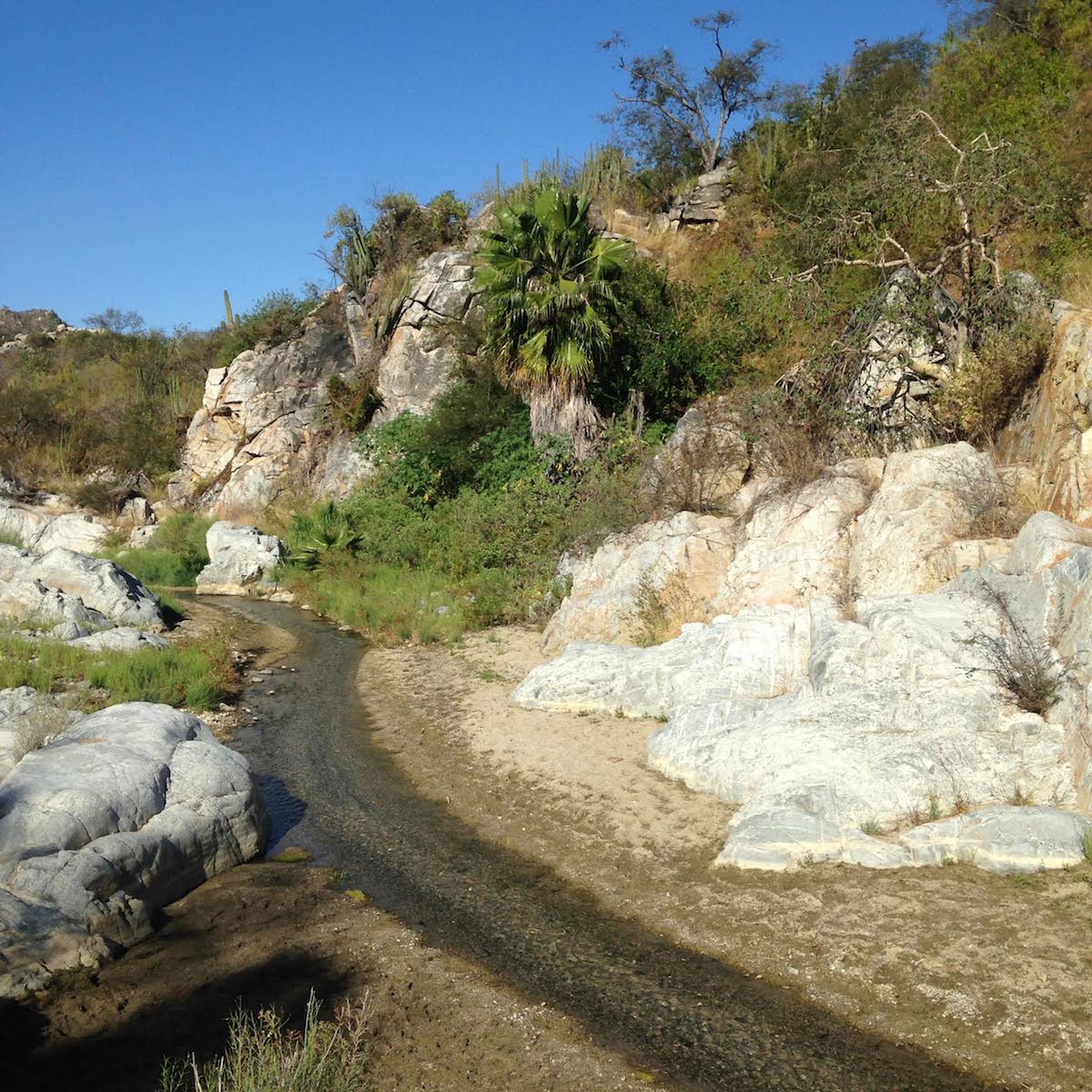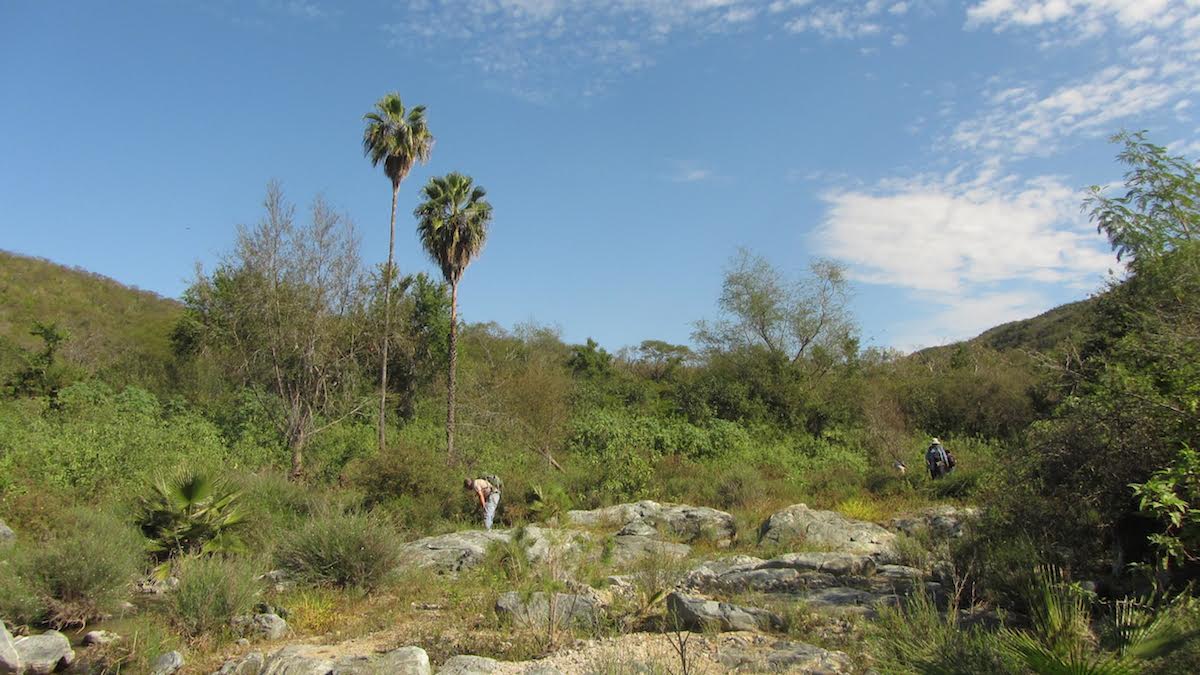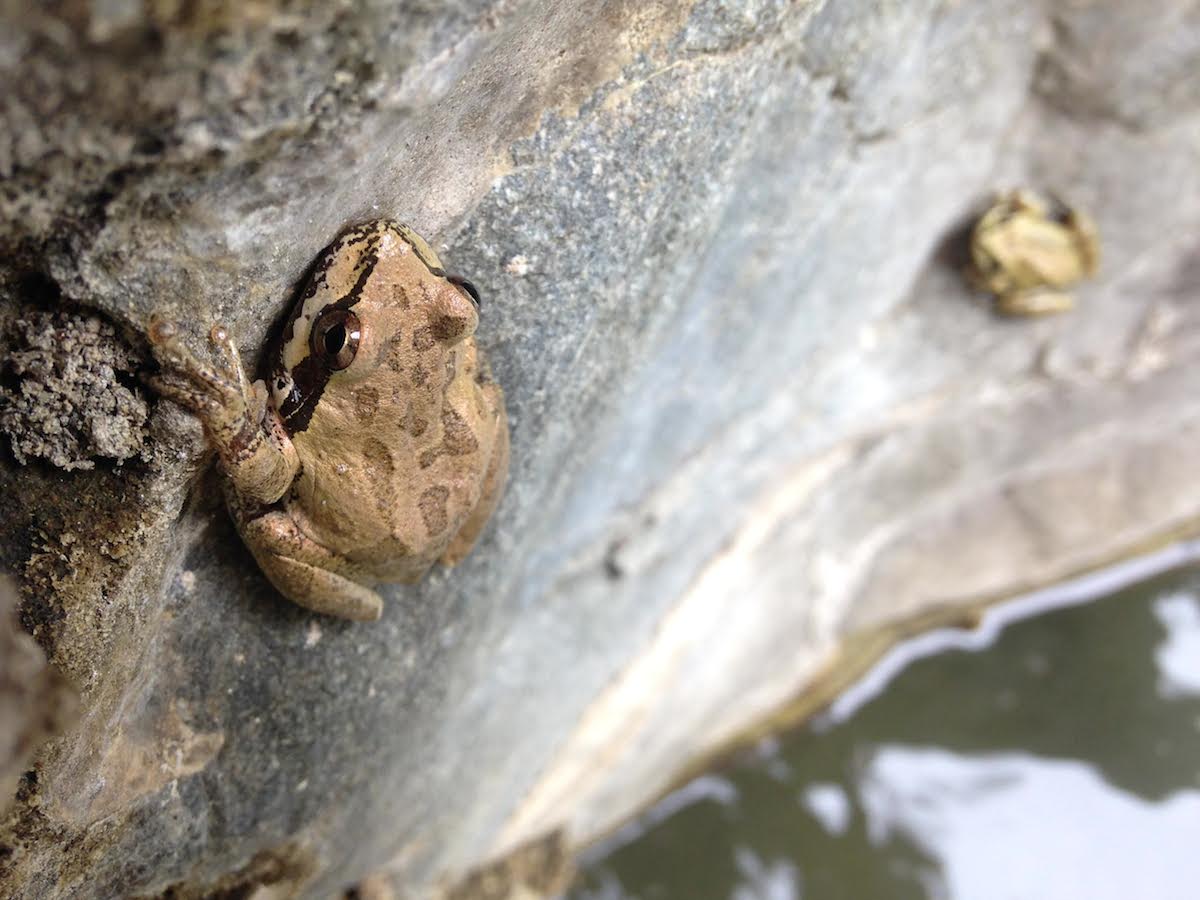- The protected area and UNESCO global biosphere reserve is the site of the hotly contested Los Cardones gold mining project.
- The survey team’s findings call into question the Environmental Impact Statement issued by the National Environment and National Resources Secretariat that found just 220 species at the site and allowed the mining project to go forward.
- Those involved with this most recent biological survey say their results challenge the efficacy of Mexico’s environmental impact evaluation process. Currently, around 19 percent of Mexico’s landmass is parceled out to more than 33,000 mining titles.
A open pit gold mine has been in the works in Sierra la Laguna Biosphere Reserve in Baja California Sur since 2007, but a new biodiversity survey may convince officials to overturn the mine’s permits. In just over a week, scientists uncovered nearly 900 species in the protected area – far more than the 220 listed by the mine’s Environmental Impact Statement that allowed the project to go forward.
Scientists from Next Generation Sonoran Desert Researchers hope that their study released in June will contribute to efforts to stop Los Cardones gold mine concession, owned by Desarrollos Zapal and Invecture Group.
Sierra la Laguna is in the center of the Baja California Peninsula, equidistant from the state capital La Paz and the beach community of Todos Santos. The threat that open pit gold mining presents to the local water supply has united coastal communities and inland cattle ranchers to take on the bureaucratic mine permitting process and influential business interests.
Ben Wilder, ecologist at the University of Arizona and director of Next Generation, said in an interview with Mongabay that the struggle over the mine raises the question, “What does a natural protected area really mean in Mexico right now?”
Sierra la Laguna is hardly the only protected area in Mexico threatened by mining. After a wave of mine concessions in recent years, 10 percent of protected areas in Mexico have mine concessions within their bounds.
Los Cardones: Sustainable mining or environmental gamble?
Los Cardones gold mine was proposed in 2007, and would extract an estimated 40 tons of gold over a ten-year period. In the process, the mining would unearth 143 million tons of rock, consume 300 million kilowatt-hours of electricity and release 150,000 tons of carbon dioxide (CO2), according to estimates by Next Generation.
The Los Cardones website explains that the mine will be a leader in “sustainable mining” and use a water processing plant to decrease its dependence on local water reserves.
Five square kilometers of the mine concession fall within the Sierra la Laguna Biosphere Reserve buffer zone. The reserve was created in 1994 and recognized by UNESCO as a global biosphere reserve in 2003.


Critics say gold mining in Sierra la Laguna would threaten more than just biodiversity. The reserve is an important groundwater charging area. Water flows from its northern ridge to the La Paz watershed before ending up in the Gulf of California. To the West, water flows towards Todos Santos and empties into the Pacific. Consuming or polluting this water would have significant effects on both sides of the peninsula, says civil society group Medio Ambiente y Sociedad (Environment and Society) in Baja California Sur.
The geography and climate of Baja California Sur pose further risks for open pit mining.
Baja California Sur has high levels of seismic activity, and on average records 100 earthquakes each year, between 4.5 and 7 on the Richter scale.
The Baja Peninsula also is prone to tsunamis and hurricanes that arrive from the Pacific. The mine’s leaching pools containing hazardous chemicals, such as cyanide, would be at risk of dangerous spills in the case of a natural disaster.
Zapal says the mine would directly generate 300 jobs and another 2,500 indirectly. The company has also committed to local corporate responsibility projects such as improving roads and providing scholarships to local students. However, local business owners have warned that the mine could also lead to job losses in the tourism industry.
Critics say other potential impacts of the mine include air pollution, desertification, soil erosion and contamination and waste overflow.
The gold rush in Mexico’s protected areas
Mexican President Enrique Peña passed sweeping energy reforms when he entered office in 2014. The previously nationalized energy sector is now gradually opening to foreign investment. While the mining sector has been open to foreign investment since 1996, Peña Nieto has awarded land concessions to both mining and energy companies at an unprecedented rate.
Currently, 18.8 percent of Mexico’s landmass, or 37 million hectares, is parceled out to 33,303 mining titles. Mexico’s mining industry is the fourth biggest in the world, with 888 active mining projects. Canadian investment, which is behind Los Cardones mine, is a main driver of mining in Mexico.

As reported previously in Mongabay, mining companies have secured concessions for 10 percent of the surface area of protected areas in Mexico. There are 2,542 mining titles within the limits of federal natural protected reserves, covering over 2.7 million hectares in 75 different national protected areas.
Mining or hydrocarbon extraction can legally take place in natural protected areas if the environmental secretary issues a permit based on the results of an environmental impact assessment. If permitted, exploitation must take place, “Without deteriorating the ecosystem, changing the landscape in a significant way, or causing irreversible environmental impacts.”
While federal authorities were evaluating the environmental impact of the proposed Los Cardones mine, state officials came out against the project in November 2013, saying it was “environmentally unviable.”
The National Environment and National Resources Secretariat (SEMARNAT) completed the Environmental Impact Statement in July 2014, and determined the mine would not integrally harm the biosphere reserve and could go forward.
The developers first had to fulfill a number of conditions, which included securing land title, permission from the national water agency and permission to change land use from forest to mining.
Who is behind Los Cardones?
The investors behind Los Cardones are enigmatic. The mine is legally registered to Desarrollos Zapal, with its offices in La Paz. Zapal in turn is a subsidiary of Invecture Group, a Mexico City-based investment firm, affiliated with Vancouver-based Frontera Mining Corporation.
Invecture owns the Cobre del Mayo/Piedras Verdes copper mine in Sonora, Mexico and the Monterde gold and silver mine in Chihuahua. Invecture’s publicly listed phone number is not in service, and an interview request at the Mexico City office was denied. Zapal representatives did not respond to an interview request from Mongabay.
Mine opponents in Baja California Sur have linked Los Cardones’ owners to one of Mexico’s richest business people: telecommunications and media magnate Ricardo Salinas Pliego. In the circle of investors associated with the Cardones mine, multiple trails lead back to Salinas Pliego’s business conglomerate, Grupo Salinas.
According to Forbes Mexico, foreign companies will reap the benefits of the reform, and that the reforms will lead to consolidation of the market, not increased competition. Salinas Pliego appears poised to become just such a player in mining and energy production. His television company, TV Azteca, has dominated the Mexican market for years, alongside Televisa.
Salinas Pliego’s daughter, Ninfa Salinas Sada, is director of the energy company Grupo Dragón and was Senator for the Green Ecologist Party of Mexico (PVEM). She was directly involved in the negotiations to modify national laws regarding industry, water and geothermal energy, a sector in which Grupo Dragón has invested heavily.
Grupo Dragón provides energy for numerous companies in Grupo Salinas, as well as two Invecture-owned mines.
On the local level in Baja California Sur, Grupo Salinas’ holdings are also entangled in the Cardones mine project. Adamantium Private Security Services is part of Grupo Salinas and has provided security both at the mine site and at a pro-mining event in La Paz in 2015.

Frente Pro Desarrollo Sustentable, or the Pro-Sustainable Development Front, is a new Baja California Sur group that promotes development projects, including the Los Cardones mine. One of its leaders is David de la Paz Ascencio, director of TV Azteca for northeastern Mexico.
“Water is more valuable than gold”: local organizing in Baja California Sur
Baja California Sur has low population density and well-preserved Pacific beaches, desert and forest. Sierra la Laguna contains the largest intact forest in the state, and Baja Californians quickly organized to oppose the mine, concerned that it would threaten the state’s principal economic drivers of tourism and agricultural production.
Cattle ranches surround the proposed mine site, on communal property plots called ejidos, which were distributed after the Mexican Revolution.
Groups based in La Paz and Todos Santos and surrounding Sierra la Laguna formed El Frente Ciudadano en Defensa del Agua y la Vida (Citizens’ Front in Defense of Water and Life). Member groups include Agua vale más que oro (Water is worth more than gold), several cattle rancher organizations, Niparaja Natural History Society and five different ejidos near the mine site.
By summer 2015, local organizers were convinced that with the state government on their side, the project was dead in the water. Baja California Sur’s reputation as a tourist destination aided their cause. The government’s stance quickly changed on July 28, 2015 when, in the final days of the local administration, the Urban Development and Ecology Secretariat of La Paz suddenly approved the land-use change request for the mine.
Following the move, El Frente Ciudadano ramped up pressure to overturn the decision, going as far as blockading local highways.
The Next Generation “Biodiversity Blitz”
The increased pressure on the state government worked, and by the end of September, state officials had reiterated their opposition to the mine. However, federal regulators would have the final say. As long as Semarnat’s Environmental Impact Statement ruled in favor of the mine, the project could stay alive.
This was where the Sonoran Desert Researchers came in. The team had caught wind of the case in summer 2014. Ben Wilder, the University of Arizona researcher, says that Next Generation aims, “to break down borders across countries and disciplines.” The interdisciplinary team brings together U.S. and Mexican researchers to study Sonoran desert ecosystems.
After researching the impacts of a proposed hotel development on the coast of Baja California Sur, the Los Cardones case came to their attention.
“It was really clear there was not much diversity information for Sierra la Laguna,” Wilder told Mongabay. “We had the model from Cabo Pulmo, we said, let’s see if we can apply it here.”
Coordinating with the National Protected Areas Commission (CONANP), Wilder and his research partners Sula Vanderplank and Exequiel Ezcurra secured permission to carry out a biodiversity study in Sierra la Laguna.
They knew the situation was tense. In 2014, the federal government required Zapal to regularize its land titles to the 18 plots that make up the mine concession before beginning activities. Without resolving the land titles, the company had been illegally entering the site. Zapal has faced a lawsuit from a cattle rancher who claimed they were unlawfully taking his land. The company was also charged with illegally removing vegetation.
Security guards were often present at the site, and the Next Generation team was meticulous in preparing the authorization documents needed to access the Biosphere Reserve.
The expedition ran from December 4 to 11, 2015. In those eight days, the team documented the presence of 877 total species, including 381 plants, 29 mammals, 77 birds, 366 insects, and 24 reptiles and amphibians.Of the species they identified, 29 are on Mexican endangered species lists, and 107 are endemic to the Cape Region – meaning they’re found nowhere else in the world. Twenty-nine scientists from 19 institutions participated in the “bioblitz,” including botanists, herpetologists, ornithologists and entomologists. Their report was published in June.



These findings far surpass the original Environmental Impact Statement that had allowed Los Cardones to go forward, which found only 220 species. Next Generation compiled a breakdown of the discrepancies between the two studies.
Wilder says there are several reasons that their study found much higher levels of biodiversity. “Scientific rigor is fundamentally lacking in the assessments,” he says. “There is no transparency in their methods and no peer review process.”
The Baja California Sur Urban Development and Ecology Department told Mongabay they had not reviewed the report and could not comment on its relevance to the permitting process.
Los Cardones: one of many
Final approval of the Los Cardones mine project is still awaiting permits from a number of government agencies, including the National Water Commission.
Next Generation’s results indicate that the Environmental Impact Statement (EIS) that allowed the Sierra la Laguna mine concessions to go forward may have lacked the scientific rigor needed to adequately assess the area’s true biological importance. Wilder says that Los Cardones “encapsulates a general trend,” in inadequate environmental assessment.
Semarnat has come under fire recently for approving EISs for projects that put at risk important ecosystems, such as the new Mexico City airport. High-profile development projects approved by Semarnat have later been overturned after prolonged citizen protest. Semarnat’s approval of the Tajamar boardwalk in Cancun was later rescinded when community groups protested the destruction of 57 hectares of mangrove for its construction.
The Los Diegos proposal for a marine mine off the coast of Baja California Sur recently lost its bid with Semarnat, indicating a recognition of the biological importance of the peninsula. While local communities have spoken out against Los Cardones for years, the Next Generation study provides detailed evidence that the mine’s approval may be on shaky ground.
“The role of Next Gen is to provide excellent objective science,” Wilder said, adding that he hopes their study will lead to a re-assessment of the original Environmental Impact Statement. As mining projects continue developing in and near protected areas across Mexico, conservationists will be watching Los Cardones to see whether rigorous science can aid citizen efforts in keeping potentially harmful industrial expansion in check.